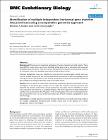| dc.contributor.author | FARES, MARIO ALI | |
| dc.date.accessioned | 2013-09-02T13:35:38Z | |
| dc.date.available | 2013-09-02T13:35:38Z | |
| dc.date.issued | 2009 | |
| dc.date.submitted | 2009 | en |
| dc.identifier.citation | Commins, J., Toft, C., Fares, M.A., Computational Biology Methods and Their Application to the Comparative Genomics of Endocellular Symbiotic Bacteria of Insects, Biological Procedures Online, 11, 2009, 52-78 | en |
| dc.identifier.other | Y | |
| dc.identifier.uri | http://hdl.handle.net/2262/67304 | |
| dc.description | PUBLISHED | en |
| dc.description.abstract | Comparative genomics has become a real tantalizing challenge in the postgenomic era. This fact has been
mostly magnified by the plethora of new genomes becoming available in a daily bases. The overwhelming
list of new genomes to compare has pushed the field of bioinformatics and computational biology forward
toward the design and development of methods capable of identifying patterns in a sea of swamping data
noise. Despite many advances made in such endeavor, the ever-lasting annoying exceptions to the general
patterns remain to pose difficulties in generalizing methods for comparative genomics. In this review, we
discuss the different tools devised to undertake the challenge of comparative genomics and some of the
exceptions that compromise the generality of s
uch methods. We focus on endosymbiotic bacteria of
insects because of their genomic dynamics peculiarities when compared to free-living organisms | en |
| dc.format.extent | 52-78 | en |
| dc.language.iso | en | en |
| dc.relation.ispartofseries | Biological Procedures Online; | |
| dc.relation.ispartofseries | 11; | |
| dc.rights | Y | en |
| dc.subject | Comparative genomics has become a real tantalizing challenge in the postgenomic era. This fact has been mostly magnified by the plethora of new genomes becoming available in a daily bases. The overwhelming list of new genomes to compare has pushed the field of bioinformatics and computational biology forward toward the design and development of methods capable of identifying patterns in a sea of swamping data noise. Despite many advances made in such endeavor, the ever-lasting annoying exceptions to the general patterns remain to pose difficulties in generalizing methods for comparative genomics. In this review, we discuss the different tools devised to undertake the challenge of comparative genomics and some of the exceptions that compromise the generality of s uch methods. We focus on endosymbiotic bacteria of insects because of their genomic dynamics peculiarities when compared to free-living organisms | en |
| dc.subject.lcsh | Comparative genomics has become a real tantalizing challenge in the postgenomic era. This fact has been mostly magnified by the plethora of new genomes becoming available in a daily bases. The overwhelming list of new genomes to compare has pushed the field of bioinformatics and computational biology forward toward the design and development of methods capable of identifying patterns in a sea of swamping data noise. Despite many advances made in such endeavor, the ever-lasting annoying exceptions to the general patterns remain to pose difficulties in generalizing methods for comparative genomics. In this review, we discuss the different tools devised to undertake the challenge of comparative genomics and some of the exceptions that compromise the generality of s uch methods. We focus on endosymbiotic bacteria of insects because of their genomic dynamics peculiarities when compared to free-living organisms | en |
| dc.title | Computational Biology Methods and Their Application to the Comparative Genomics of Endocellular Symbiotic Bacteria of Insects | en |
| dc.type | Journal Article | en |
| dc.type.supercollection | scholarly_publications | en |
| dc.type.supercollection | refereed_publications | en |
| dc.identifier.peoplefinderurl | http://people.tcd.ie/faresm | |
| dc.identifier.rssinternalid | 87385 | |







